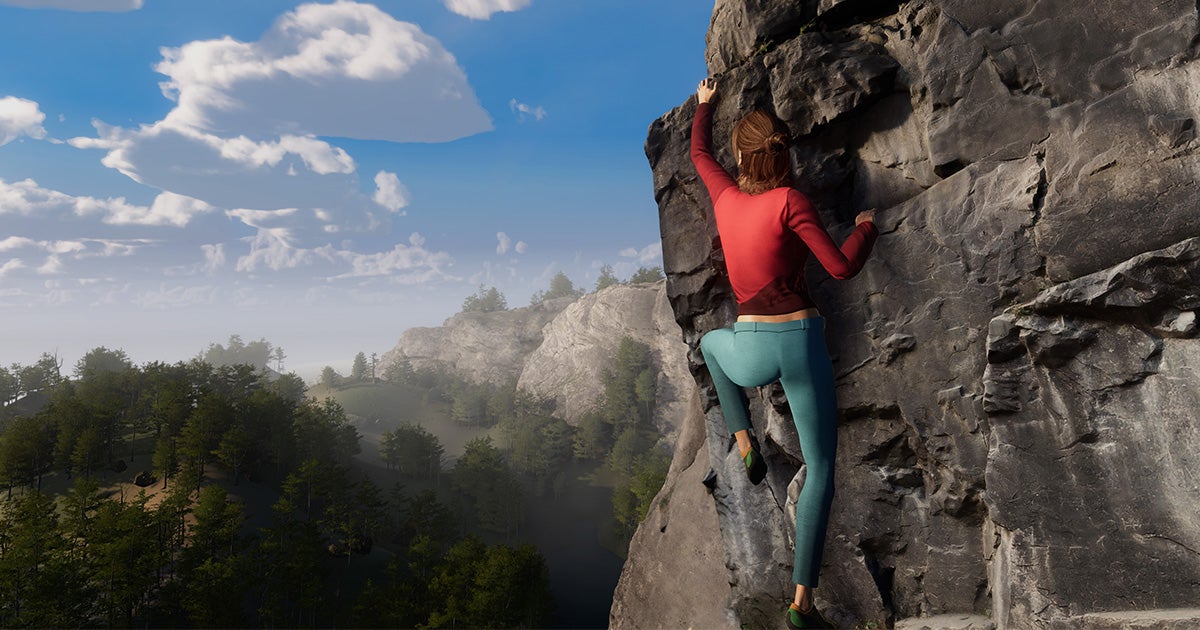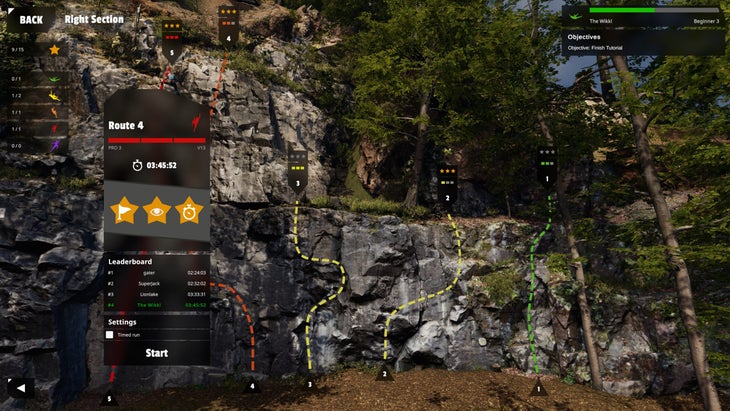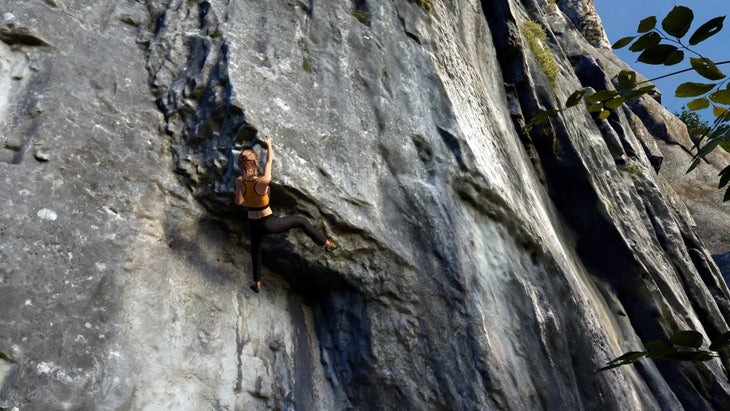This New Rock Climbing Sim is the Game You’ve Always Dreamed Of

“New Heights” is the first video game to capture the physics of rock climbing. Every climber should give it a try.
The post This New Rock Climbing Sim is the Game You’ve Always Dreamed Of appeared first on Climbing.

I’ve been playing video games far longer than I’ve been climbing. It was adventure games like The Elder Scrolls IV: Oblivion that gave teenage me the itch to get off my ass and explore the world in the first place. So, from my first days tying figure eights, I’ve been waiting for a game that would do our sport justice.
That was 16 years ago. Unfortunately, every climbing video game I’ve played during that time has, well…sucked.
Either game developers go full bonkers, with absurd double dynos and swings and grappling hooks and wall-running, or they make games that are so controlled and boring that they may as well be a camouflaged crossword puzzle. Minigames like the infuriating GIRP and the snoozefest Crux may have aped the motions of climbing. But these fail to even approach the unique physics, not to mention the sheer diversity and freedom of movement, that makes rock climbing so special.
Enter New Heights.

I’ve spent the past couple of weeks playing this climbing simulator from indie developer Wikkl Works, which is currently available in early access for $22. Not only is it the best climbing game ever created, but it also has the potential to augment climbing performance on real rock. If you’re like me and you’ve always dreamed of a video game that captures the essence of rock climbing, the wait is over.
New Heights has you controlling an unnamed, noodle-limbed woman as she tackles an array of rock lines, from 10-foot boulders to 200-foot cliff faces. There are around 250 routes in the game currently, with more on the way, spread out between a bouldering gym training ground and two expansive outdoor regions, the Ardennes and Fontainebleau.
Each region offers a number of crags, from the soaring faces of Al’Lègne to the famed boulders of Éléphant. Each crag offers a number of cliffs and faces, each with a variety of routes. There are also human made structures you’d never be able to climb in real life, like an ancient castle and a crumbling cathedral.
Every surface was meticulously crafted using photogrammetry, a technology that allows developers to overlap multiple two-dimensional images of a surface to create a three-dimensional render. That means in New Heights, you aren’t just climbing random routes made up by some flabby goon behind a keyboard. You’re climbing true-to-life digital renditions of legendary faces.
You “climb” in New Heights by moving each of your four limbs, one at a time, and hovering your cursor over the rock face to grab onto holds. Possible holds are illustrated by an arrow (or a circle for smears), which fills up from red to orange to green based on how bomber the hold is, and rotates based on the direction of your force. For example, an arrow pointing away from your avatar means you’ll be pulling on the hold, while an arrow facing toward your avatar denotes pushing. The controls take a bit to get used to, but after an hour or so of playing it became second nature, and that’s when the game really started to get fun.
Like real rock climbing, holds aren’t inherently good or bad. They’re increasingly positive or negative based on your weight distribution and body position, controlled in six directions by Q, W, E, A, S, and D. Holds that incorporate opposing forces also get a grip bonus, just like stemming in real life. Surfaces with particularly sharp edges or cavities (pinches, cracks, pockets) offer a grip bonus as well.
The result is that New Heights allows all of the same techniques we use in real climbing, from flagging and mantling to laybacking and underclinging. (Jamming is perhaps the only exception.) As of a recent update, players can even dyno. My dynos in New Heights, unfortunately, are nearly as bad as in real life. About half of my jumps sent my avatar pinwheeling into the abyss.
The game is largely static, meaning if you lock onto four or three good holds you can hang on endlessly. However, as soon as you shift your weight into a subpar position or remove one of your limbs from the wall to search for another hold, reducing your overall grip, a timer will appear, winnowing down at a speed proportional to how bad your position is. If the timer runs out, your avatar blows off the wall and falls to the ground, crumpling up like a pile of silly string.
Routes are graded using the V-scale (even though many are full-length pitches, and some are multi-pitch routes). Each route offers three possible stars. You earn one star for finishing the route, and one additional star each for finishing it without any falls and within a given time limit. Stars unlock additional locations.
While there are a few hundred established routes in the game, you can also play in “explore” mode and run around scaling any surface within the game environment.

Last week I spoke with New Heights’ co-creator, Guido Boogaard, who has been climbing for 10 years. Boogaard, who is based in Utrecht, the Netherlands, said the game started as a part-time hobby, something “larger than life” that he toyed with in his free time.
Originally, he envisioned New Heights as a story-driven cartoon adventure game, but as he and his partner, Finn van der Heide, began developing the mechanics behind the climbing, he became obsessed with the idea of trying these mechanics out on renders of real cliffs.
“Our goal was to make a fun game with the mechanics of climbing,” Boogaard said. “I didn’t want to completely replicate climbing. That’s impossible. I also didn’t want to make a boring game. The game has to be fun first, and then it should be based on the same physics elements that are present in climbing.”
Boogaard and his team traveled to each of the crags shown in the game and scanned them inch by inch with remote-controlled drones, painstakingly mapping every crack, ledge, roof, and dish, down to holds no more than a few inches wide. He estimated that they took several thousand photos of the Al’Lègne crag alone, spending multiple days photographing each crag.
It’s worth noting that New Heights isn’t perfect. The complete freedom of movement is part and parcel of some wonky ragdoll mechanics and often ludicrous body positioning. On one occasion while stemming up a water groove, I twisted my character’s legs into a pretzel knot and could not manage to untie them, leaving myself essentially paralyzed from the waist down. (I was then forced to commit suicide, holding “R” to jump off the wall and restart.)
As cool as the photogrammetry is, it’s also not 100% accurate. Sometimes a hold that is obviously terrible gives you bomber support, and a hold that is clearly a monster jug responds like a credit card crimp. (There were times when my character got a better grip grabbing a clump of moss than a rock.) Once I latched onto an absolutely killer hold only to take a closer look and realize I was grabbing onto a permadraw, which must have been photographed when Boogaard and his team did their scans of the crag.
But New Heights brought a remarkably similar experience to real climbing. My hands got sweaty. I was cussing wildly as my stamina bar drained. I told myself I needed more caffeine. I listened to Creed’s banger “Higher” to get myself hyped up. (Basically, all the same patterns of behavior I have when I’m struggling with a project in real life.) Even my forearms got a little pumped from all that mouse-clicking.
What’s exciting about New Heights isn’t its current manifestation, but where it’s headed. In addition to streamlining the mechanics ahead of a full launch in early 2025, adding new crags, and new features like roped climbing and a cooperative mode, Boogaard said that in coming weeks he and his team will add a self-scan feature.
This means that, in partnership with a smartphone application, climbers can photograph cliffs and boulders in the real world and upload them into the game, using the same photogrammetric technology Boogaard and his team used to create the crags in the base game. “You can scan your boulder project, and practice on it in New Heights,” Boogaard said. “Scan a loaf of bread and climb it in New Heights. Scan your face and climb it in New Heights. Basically, anything three-dimensional that you can photograph, you’ll be able to climb it.”
As the game is fine-tuned, it’s not a stretch to say that New Heights could even help climbers dial in tricky projects, in much the same way we visualize sequences in our minds before we hop on a boulder problem.
Unfortunately, Boogaard and his little team haven’t managed to blow up just yet. Despite overwhelmingly positive reviews and a dedicated fanbase, he said the game has only sold around 4,500 copies since its early access launch last July, primarily to niche gamers in the United States, Japan, and South Korea. “Making money was not our primary goal, but I must say the amount of sales we’ve had is not as much as we’d hoped,” he said. “But we believe that once people can design and upload their own routes, the game has the potential to stay alive forever.”
New Heights is currently available on PC for $21.99. Boogaard says a Mac and console port are in the pipeline.
The post This New Rock Climbing Sim is the Game You’ve Always Dreamed Of appeared first on Climbing.
